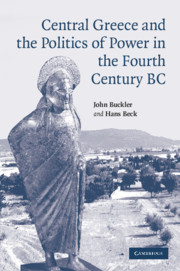Book contents
- Frontmatter
- Contents
- List of maps
- Preface
- Acknowledgments
- List of abbreviations
- Prologue
- Part I ALLIANCE
- Chapter 1 A survey of Theban and Athenian relations between 403–371 BC
- Chapter 2 The incident at Mt. Parnassus, 395 BC
- Chapter 3 The battle of Coronea and its historiographical legacy
- Chapter 4 The King's Peace, alliance, and Phoebidas’ strike (382 BC)
- Chapter 5 Sphodrias' raid and the evolution of the Athenian League
- Part II HEGEMONY
- Part III DOMINATION
- Epilogue
- Glossary
- References
- Index
Chapter 3 - The battle of Coronea and its historiographical legacy
from Part I - ALLIANCE
Published online by Cambridge University Press: 22 September 2009
- Frontmatter
- Contents
- List of maps
- Preface
- Acknowledgments
- List of abbreviations
- Prologue
- Part I ALLIANCE
- Chapter 1 A survey of Theban and Athenian relations between 403–371 BC
- Chapter 2 The incident at Mt. Parnassus, 395 BC
- Chapter 3 The battle of Coronea and its historiographical legacy
- Chapter 4 The King's Peace, alliance, and Phoebidas’ strike (382 BC)
- Chapter 5 Sphodrias' raid and the evolution of the Athenian League
- Part II HEGEMONY
- Part III DOMINATION
- Epilogue
- Glossary
- References
- Index
Summary
In 395 BC the Corinthian War erupted between Sparta and its allies and an alliance of Thebes, Athens, Corinth, Argos, and others. At the time the Spartan king Agesilaus and a veteran force pursued a desultory campaign in the western satrapies of the Persian Empire. After Spartan armies had suffered defeat at the battle of Haliartus and fought the indecisive battle at Nemea River, the home government recalled Agesilaus and his force to defend Spartan interests in Greece. Spartan naval weakness compelled Agesilaus to make a long overland march back to Greece. Upon the king's entry into Boeotia on 14 August 394, he encountered a defending force of Thebans and their allies at the plain of Coronea in central Boeotia. The ensuing battle between these forces has more than marginal significance, for it can be demonstrated that larger developments stemmed from this event. To understand it all properly one must locate the actual site of the battle, correctly interpret the course of it, and then realize the historiographical implications of it and the merits of the ancient historians who recount it.
THE BATTLEFIELD
The sources for the location of the battlefield and for the course of the battle itself are abundant but of varying quality. The best, but perhaps the most refractory, is Xenophon, himself a field commander and a participant in the fighting. Diodorus of Sicily later epitomized the account of the fourth-century historian Ephorus, who was not especially esteemed, even in antiquity, for his knowledge of military affairs.
- Type
- Chapter
- Information
- Publisher: Cambridge University PressPrint publication year: 2008
- 2
- Cited by



